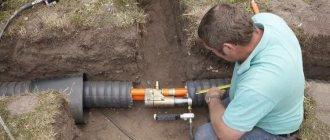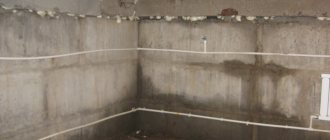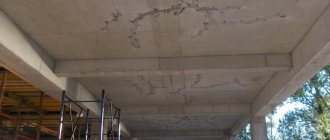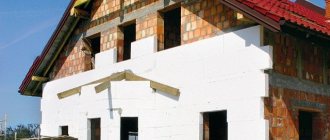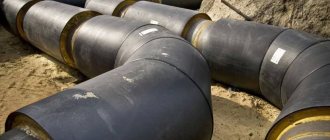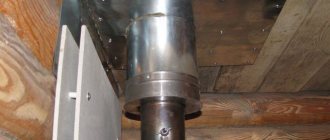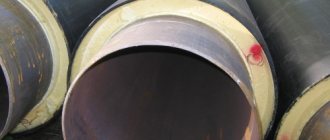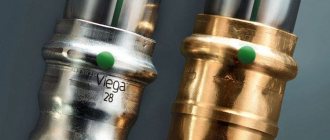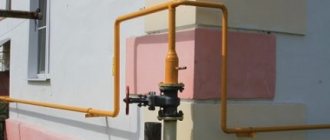Very enhanced protection
Very reinforced insulation effectively solves the problem of corrosive formations appearing on the pipeline.
But this problem always remained acute. Regardless of the installation option, pipes are always under the influence of water and oxygen. And these are the main factors that cause corrosive formations on metal. If the pipeline runs underground, it is also affected by groundwater, which is often chemically aggressive.
If we consider the following methods of using VUS:
- A traditional option for strengthening steel pipeline systems is their treatment with bitumen and bitumen-rubber mastics. A protective or reinforcing coating is applied to this treatment. The normal level of this treatment is considered to be the presence of a couple of layers of mastic, the thickness of which is 0.3 cm, and a layer of protection made of kraft paper.
- For VUS, mastic is applied in four layers. The second and third layers are separated by rolled reinforcing material. Kraft paper acts as the main coating, which protects against mechanical influence.
- The next method is an even more enhanced treatment, consisting of six layers and a pair of reinforcement layers. The thickness of the protective layers in this version is 0.9 cm.
Video
Coating Equipment
Application of the TERMA-ST coating must be carried out by trained workers. To prepare the surface to be coated, the following equipment is required:
- gas burner - 1 pc.;
- propane cylinder with reducer – 1 piece;
- connecting gas hose 1 Ohm - 1 pc.;
- contact thermometer with a measurement range from 0 to 150° C;
- press rollers;
- heat-resistant gloves, mittens, protective helmets, goggles;
- sander, file, sandpaper.
Regulatory documents and their requirements
There are 3 main documents regulating the organization of gas pipeline protection. RD 153-39.4-091-01 “Instructions for the protection of urban underground pipelines from corrosion.” As the name implies, it does not apply to the insulation of gas pipes with a diameter greater than 83 cm - intercity and international, as well as to pipes laid above ground or under water.
GOST 9.602-89 is a related document that contains all the standards and calculations for the protection of underground gas pipelines. If the instructions explain how and what to make insulation from, then GOST indicates how much of what will be required - from meters of material and tools to equipment and labor hours of workers.
GOST R 51164-98 Main steel pipelines. General requirements for corrosion protection. This standard fills a gap in the Instructions regarding main pipelines. Their protection must be especially reliable and has its own specifics, therefore the rules for its organization are included in a separate document.
As a rule, gas pipelines of national and international importance have a diameter of more than 830 mm, their installation and maintenance is labor-intensive and expensive.
These documents regulate the following issues:
- what types of materials are allowed to be used on this type of gas pipeline under these conditions;
- how much reinforced insulation is needed, is electrochemical protection needed;
- who and when is obliged to provide the gas pipeline with the necessary protection;
- technology for applying insulation at the factory and in the field, as well as for repairing damage;
- norms for the consumption of materials and costs of other resources for carrying out work;
- the procedure for checking the quality of the coating and standards for quality indicators for all parameters for each type of insulation.
Thus, these documents describe the entire process of pipe insulation step by step, from release at the factory to inspection after installation and during operation. There is no room left for creativity, because these are security issues.
In case of damage or poor-quality application of the insulating coating, the steel in the ground rusts quite quickly, and this threatens a gas leak and fire
There are also separate lists that list all the recommended materials and manufacturers of insulation for gas pipelines.
Considering the complexity of the work and the considerable number of standards that must be observed, do not even expect to cope with the insulation of the gas pipeline yourself, and the gas service will not accept work performed by a third-party specialist.
PPU insulation
PPU is the name of the material “polyurethane foam”. It completely covers the pipe, forming a thick protective layer. The top is covered with a polyethylene or galvanized shell.
Such pipes are necessarily equipped with an ODC system (operational remote control), which prevents an accident from occurring and warns the operator about the appearance of problem areas on the surface of the pipeline.
PPU pipes are much easier to install in the ground compared to other types. They are more wear-resistant and durable (30 years of operation are guaranteed by the manufacturers). They have low thermal conductivity and high mechanical security.
Polyurethane foam pipelines are used when constructing heating mains. They successfully transport liquid substances of different temperatures, gases (for heating), chemicals and petroleum products. The cost of purchasing and laying polyurethane foam pipes is much lower than the cost of other types.
How to spray PPU with your own hands?
Do-it-yourself equipment for PPU is a profitable purchase for work in small areas: insulation of chimneys, ventilation hatches. Installing a PPU with your own hands (assembling the components of the structure into one whole) is not cheap, approximately 120 thousand rubles. Therefore, it is better to purchase ready-made disposable kits for carrying out work.
When working, you should follow safety precautions:
- The room must have forced ventilation.
- Work should be performed in special clothing - a protective suit, and a respirator should be put on the face.
Insulation with polyurethane occurs in several stages:
- The surface on which the spraying will be applied is first prepared: cleaning from dirt, rust, degreasing.
- To obtain an effective layer of polyurethane foam, it is necessary to ensure the required temperature of the solution: 10-25 degrees.
- Equipment for spraying polypropylene resin with your own hands consists of a spray gun and two cylinders. They are intended for polyurethane components. One is for polyol with freon, the other is for isocyanate. The hoses with the gun are connected to the gearboxes. When the gun is pressed, the liquids are mixed.
- If necessary, an additional layer is applied.
The most effective self-made insulation is considered to be made in 3 layers. First, 14 mm thick polyurethane foam is applied, after drying, the surface is covered with 2 more layers at short time intervals.

Checking the quality of insulation application
The protection of steel gas pipelines is a responsible undertaking, therefore, each operation performed is subject to thorough inspection, with the drawing up of a report of hidden work performed and entering them into the pipeline passport. No matter how high-quality and correctly selected the insulation material is, it will not cope with the functions assigned to it if the technology for carrying out the work has been violated.
The main parameters of the finished coating to be checked are thickness, continuity and adhesion to the pipe. They are measured with special electronic devices: thickness gauges, spark flaw detectors and adhesive meters, respectively. They do not damage the coating, so they allow you to control all questionable points without extra costs.
In factory conditions
At factories and production bases, the thickness of the coating is checked on 10% of the pipes of each batch, in 4 places on different sides in a circle on each pipe, as well as in doubtful areas.
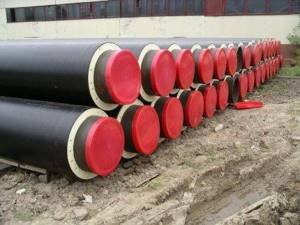
The insulation applied to pipes by the manufacturer is always more uniform, better quality and more reliable than that organized in the field, even when using similar materials
Adhesion, or the force of adhesion to metal and between layers, is also required by standards to be checked for 10% of the products in a batch or every 100 m.
The continuity of the coating, that is, the absence of punctures, scuffing and other through violations, is checked on all insulated products over the entire area.
In addition, dielectric continuity of the coating, impact strength, peel area after cathodic polarization and other tests can be checked. When insulating with bitumen coatings, a sample for physical properties is taken from each batch of mastic, at least daily.
At the installation or repair site
Under route conditions, the quality of insulation is also checked, for continuity - always and completely, and for thickness and adhesion - every 10th insulated weld.
In addition, the width of the overlap on the factory coating is checked, as well as the insulation relief - for the absence of corrugations, wrinkles, air cushions and other defects.
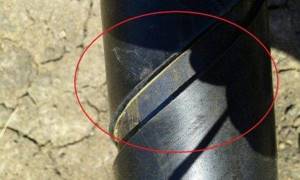
If the adhesion of the insulating tape to the pipe is weak, over time it will peel off and the pipe will be unprotected from the environment
In addition, the continuity of insulation on existing gas pipelines is regularly checked. To do this, you don’t even need to dig them up, and if damage is suspected, the pipes are exposed and not only the thickness, continuity and adhesion are checked, but also the dielectric properties of the insulation.
Conclusions and useful video on the topic
Now you know everything - or almost everything - about the purpose and materials for insulating various steel gas pipelines, and also have an idea about the features of their application and checking the quality of protection.
And for greater clarity, we suggest watching a video that describes in detail how to insulate welded joints with bitumen-polymer tape:
Installing a heat-shrinkable sleeve on a weld seam:
Perhaps you have already encountered similar work, observed its implementation or took direct part. Please add or evaluate the information provided. We'd love to hear your thoughts in the discussion below.
Protective shell
External insulation of pipelines solves many problems:
Only stainless steel products are not subject to corrosion. However, the cost of the latter is very significant, so most communications are made from ordinary black pipes. Such an alloy is much more susceptible to corrosion, and the protective shell can significantly reduce damage and extend the life of the product;
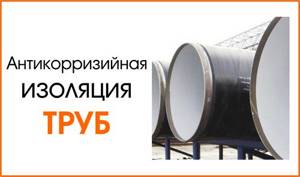
Insulation against corrosion
- metal conducts heat, releasing it to the air and earth. To maintain the temperature of the coolant, steel pipes are insulated using polyurethane foam, extruded polyethylene, and mastic;
- freezing of liquid in steel pipes is fraught with damage to the latter: water expands when freezing and breaks metal of any strength. Thermal insulation will avoid this phenomenon;
- the insulating shell protects steel pipes from mechanical damage, especially with an open installation method;
- Prices depend on the complexity and effectiveness of the insulation.

Reliable insulation
Only the simplest options can be carried out manually, for example, applying one layer of mastic.
Extremely reinforced insulation of steel pipes
Reinforced insulation of steel pipes GOST 9.602-2005 looks like this.
- The traditional option involves treating the surface with bitumen and bitumen-rubber mastic. The normal level is considered to be 2 layers of mastic 0.3 cm thick and a kraft paper pad. A protective layer is applied on top of the coating. The prices for the method and materials are the most affordable.
- Very enhanced protection requires at least 4 layers of mastic. In this case, a reinforcing roll material is placed between the 2nd and 3rd layers. The top shell made of kraft paper protects from mechanical damage.
- Insulation of reinforced steel pipes also involves another, even more reliable option: 6 layers of mastic and 2 layers of reinforcement. Moreover, their thickness is at least 0.9 cm. The photo shows a protective shell in accordance with GOST.
None of the protection methods involve a manual installation method.
The described methods are suggested by GOST 9.602-2005. This is truly reliable and durable protection. However, in difficult conditions - high groundwater levels, channelless laying of steel pipes - this is not enough.

Pipe insulation
Reinforced insulation according to GOST 9.602-2016
Materials of a different type are used, although the base is still bitumen or bitumen-rubber mastic.
The university includes the following:
- the surface of the steel pipe is primed;
- reinforced fiberglass fabric is fixed on the product - the first layer;
- then a layer of bitumen mastic is applied to provide protection against water;
- 3rd layer – another fiberglass gasket;
- mastic and 1 or 2 protective layers of kraft paper.
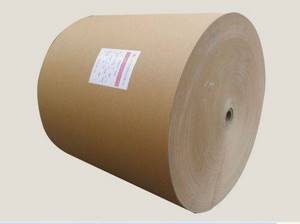
This option ensures minimal permeability of oxygen and water, mechanical strength and resistance to the most severe temperature changes. The prices for such insulation are, of course, higher.
GOST suggests another method - again, not a manual method, using polyethylene tape material. The technology is almost the same, that is, alternating polyethylene gaskets and layers of mastic. Reinforced steel pipe insulation is shown in the photo.
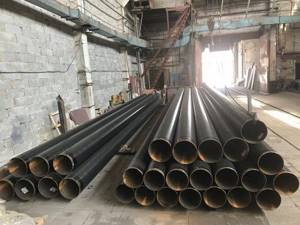
The use of polymer materials guarantees complete insensitivity to moisture in any form and resistance to mechanical damage. The treatment also ensures excellent temperature retention: GOST recommends the use of protection on pipelines where the temperature of the transferred substance ranges from -40 to +60 C.
Why is this necessary?
- Condensation control. When the temperature is not maintained, condensation forms in the pipes, and over time, water accumulates. Proper insulation using appropriate cladding will minimize the likelihood of condensation.
- Corrosion protection. Over time, metal corrodes, but special coatings slow down this process.
- Noise control. During operation, pipes can create vibrations and even knock. If they are properly insulated, excessive operating sounds are kept to a minimum.
- Safety. As the temperature rises, there is a risk of accidents, and the protective layer minimizes the risks by maintaining the temperature within the acceptable range.
- Reducing costs associated with fuel losses. With high-quality insulation, there are practically no energy losses.
Types of insulation materials
Based on operating conditions and ease of use, there are many types of coatings for insulating gas pipes. It is enough to protect above-ground gas pipelines with 2 layers of primer and 2 layers of paint or enamel.
Pipes that will serve on the seabed are covered with a layer of concrete on top of the main insulation for weight and additional protection.
Next we will talk about means of protecting underground steel pipes.
Polymer protective coatings
Extruded polyethylene is the most progressive and universal protection. It is used on pipes with a diameter of 57 – 2020 mm, it sticks tightly, forms a perfectly uniform continuous layer, protects against temperature and mechanical influences, and is also convenient to use.
In such a coating, a steel pipe is practically not inferior in terms of protection characteristics to its polymer analogues. This protection consists of only 2 layers - a rigid adhesive and, in fact, polyethylene. Despite this, such a highly reinforced coating on large diameter pipes can reach 3.5 mm.
Extruded polypropylene is specific for its high mechanical strength: with it you can pull pipes through wells, for closed installation methods, and not worry that the insulation will be damaged by friction or snagging on stones and soil. Externally and in structure, this type of insulation does not differ from polyethylene, only 0.3 - 0.5 mm thinner.
Polymer adhesive tapes are made of polyethylene and polyvinyl chloride, with the former being preferable because they adhere 4 times more firmly and protect pipes better. Most often, adhesive PET tapes are used to repair and insulate joints of pipes coated with extruded polyethylene, but there are also pipes wrapped with them at the factory along the entire length.
There is also a combined PET coating, in which the primed pipe is first wrapped with adhesive polymer tape and protected on top of it with a layer of extruded polyethylene. It is used on pipes with a diameter of up to 53 cm, and the total thickness does not exceed 3 mm.
Insulation based on bitumen mastics
This insulation differs fundamentally in composition and properties, primarily in the method of application. The adhesion of bitumen both to the pipe and the layers to each other is ensured by heating and melting of the material itself, and not by an adhesive primer, as is the case with PET.
This coating is applied to a special bitumen primer and consists of 2-3 layers of mastic, each of which is reinforced, and an outer protective paper wrapper. As a result, a continuous coating is formed that completely follows the shape of the pipe, where the reinforcing fiberglass or mesh is as if soldered into the thickness of the protection.
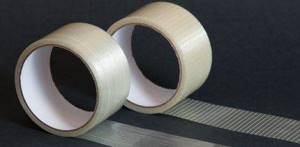
Fiberglass, fiberglass mesh or non-woven polymer fabric are used as reinforcing material. Fiberglass strips are wound with slight overlap to form a continuous layer
The mastic itself, in addition to bitumen, contains various inclusions - polymer, mineral or rubber - providing different properties of the material. Modifying additives and plasticizers are also added to it, which add elasticity, flexibility, resistance to critical temperatures and durability to the natural hydrophobicity and adhesion ability.
There are also tapes that connect bitumen as an adhesive and special polymer tapes. The main 2 types of such coatings are PALT, with heat-shrinkable tape, and LITKOR, made of polymer-bitumen tape. The latter, in particular, is necessary to protect connections between pipes with different types of insulation.
Materials for insulating small elements
Base terminals, corners, elbows, condensate collectors and other shaped elements of gas pipelines also need protection.
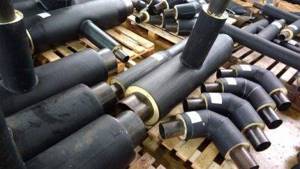
It is more convenient to insulate small parts at the installation site, but the factory coating is preferable because it is more uniform and reliable
There are special coatings for this: PAP-M105 and Polur. The first is two layers of cured polyester resin reinforced with glass fiber.
Semi-lure consists mainly of polyurethane, supplemented with technological additives and divided into a main component and a hardener. With the help of these two compounds, shaped joints are insulated both at the factory, in workshops, and directly on the route.
How to choose a material for waterproofing a gas pipeline
Among modern solutions used as waterproofing for gas pipes, the following are in demand:
- bitumen mastics, which can be produced with various additives (rubber, mineral, polymer). Additives to bitumen enhance the quality and physical properties of the material, improve adhesion to the surface of the main pipe, and also protect against cracks. In addition, this type of insulation has proven its worth in difficult operating conditions (for example, at sub-zero temperatures);
- tape waterproofers. The main material of manufacture is PVC (polyvinyl chloride) or polyethylene. One side of this tape has an adhesive layer, which ensures that the tape is attached to the pipe.
When is thermal insulation of cold water supply pipes necessary?
Insulation for cold water supply pipes is carried out to protect them from external breakthroughs and freezing, and prevents corrosion and condensation formation.
What are the causes of condensation and where does it form? Fogging of pipes is the moisture that appears on them, which usually appears:
- On cold parts of the surface.
- As a result of contact with warm air, greater humidity. The steam contained in the warm air, when cooled, is converted into moisture in the form of precipitation on the cold pipeline.
Condensation is formed as a result of:
- Contact of too cold pipeline with surrounding warm air.
- High humidity of the external environment.
- Insufficient ventilation of the room.
- Water supply faults.
Consequences of condensation:
- Unaesthetic appearance of a fogged pipe.
- A collection of puddles beneath them.
- High humidity.
- The appearance of mold combined with a heavy odor.
- Corrosion of metal pipes.
If the pipe is of small diameter, it is best to use specially designed pipe casings made of heat-insulating porous foam. This type of insulation can be installed by hand, having previously selected the desired size - the inner diameter of the shell must correspond to the outer diameter of the pipe.
The shell is cut along its entire length, placed on a previously dried pipe, and the resulting seam is sealed with tape or glue. The result is an aesthetic appearance combined with reliable pipeline protection.
To install insulation for a large diameter pipeline, it is necessary to use flat sheets, rolls of different thicknesses with the addition of an adhesive layer and aluminum foil.
Seams and joints are connected:
- glue;
- self-adhesive tapes made of rubber and aluminum;
- clips.
With their help, they achieve tightness and reliable insulation.
Pipe laying methods
On the street, insulation of heating pipelines is required both when installed above ground and when laid hidden - underground. The latter method is a channel method - a reinforced concrete trench is first laid in the trench, and pipes are already placed in it. Channelless placement method - directly in the ground. The insulating materials used differ not only in thermal conductivity, but also in steam and water resistance, durability and installation methods.
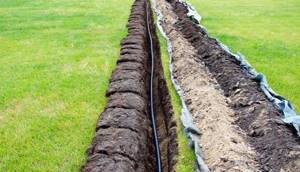
The need to insulate cold water supply pipes is not so obvious. However, you cannot do without it when the water supply is laid open above ground - the pipes must be protected from freezing and subsequent damage. But inside buildings, water supply pipes also have to be insulated - to prevent moisture condensation on them.
What materials are used
This type of insulation is made of thin galvanized steel in the form of cylinders or shells of different diameters, from which you can choose the right option for any external pipeline.
Installation of galvanized protective shells is carried out on previously fixed heat-insulating material:
- polyurethane foam. This insulator has a low thermal conductivity coefficient, hygroscopicity, durability, good adhesion to steel and shell material, and is applied by spraying. By agreement with the customer, pipes in polyurethane foam insulation (PPU) are equipped with an ODK (operational remote control) system. It allows you to obtain real-time information about damage to the steel pipe and shell, the appearance of places where the thermal insulation layer is moistened, and malfunctions of the signal wire;
- PPU shells are products made of polyurethane foam, made in the form of detachable cylinders, half-cylinders, prefabricated elements. Fixed on the pipe using a tie;
- foam polymer mineral. The material has a low water absorption coefficient and retains heat well in the pipeline. The cost of foam-polymer-mineral insulation (PPM) is lower than other thermal insulator options;
- extruded polyethylene. Pipe insulation using extruded polyethylene is considered reinforced insulation (RUS). It is applied in a factory and forms a completely waterproof layer that is resistant to temperature changes and the effects of various chemical compounds and aggressive environments;
- rubber - bitumen mastic. Performs the function of waterproofing metal pipes without affecting the reduction of their thermal conductivity. The technology of insulation with rubber-bitumen mastic involves the application of several layers: a primer that increases the adhesion of metal surfaces, polymer-bitumen mastic and non-woven fabric for reinforcement. Polymer film or galvanization is used to wrap the insulated surface of the pipes.
Insulation with mineral wool insulation
Such heat insulators have also proven their worth in ensuring the protection of main gas pipelines. Mineral wool insulation demonstrates:
- low thermal conductivity (due to the fibrous structure, air is retained inside the material);
- resistance to thermal loads;
- high fire resistance;
- resistance to water, biological organisms and chemical reagents;
- environmental friendliness (safe composition and additives used do not harm the environment or human health).
ZTI AMAKS offers enterprises highly reliable thermal insulation materials of its own production. We manufacture and sell a wide range of heat-insulating products, including mineral wool cylinders, tufted mineral wool mats, mounting tapes, extruded polystyrene foam segments, polyisocyanurate foam segments and much more.
Experienced specialists will select an effective insulator taking into account the characteristics and objectives of your facility and budget. Flexible pricing policy and individual conditions make cooperation with us economically profitable. We also offer delivery to any point in our country quickly and reliable transport (road, railway, special equipment).
Contact us in a way convenient for you: through the feedback form, by phone and receive comprehensive information on our production capabilities, assortment and terms of cooperation.
Gas pipeline insulation
To insulate pipes transporting gas, various types of insulators are used. For example, you can thermally insulate a gas pipeline using special paint or varnish, but in most cases modern protective materials are used.
What requirements must an insulator for gas pipes meet:
first of all, the insulator for the gas pipeline must be able to be uniformly, monolithically mounted on the pipe; and it is also very important that the insulating material for the pipeline has a low coefficient of water absorption and generally high waterproofing properties;
The material for insulating gas pipes must have high moisture resistance
- also, high-quality protective material must be highly resistant to corrosion and the effects of any other aggressive chemical compounds;
- the insulator must be quite strong to protect the gas pipeline from mechanical stress;
- the coating must not have any damage (cracks, chips, etc.).
Let's consider the main types and types of gas pipeline insulation:
bitumen mastics. Such heat insulators are produced with various additives that are mixed into the base material - bitumen. Additives can be of three types:
- Polymer.
- Mineral.
- Rubber.
Such additives provide protection against cracks and, in addition, improve adhesion to the surface of the gas pipe. It is also worth noting that bitumen mastics have proven themselves at low temperatures.
tape materials. Insulating tapes are usually made of polyethylene or polyvinyl chloride (PVC). At the production stage, an adhesive material is applied to one side of such a tape, through which the tape is installed on the gas pipeline.
Depending on the design features of the pipeline and the region in which it is laid, the following types of tape insulation are used:
- Regular.
- Reinforced (RS).
- Very enhanced (VUS).
To protect gas pipelines today, tape insulation is often used, which is wound onto the pipes using a special device.
The latter type of insulation is the most reliable and effective and is most often used to protect pipelines in populated areas. VUS is resistant to aggressive corrosive influences and active chemicals.
VUS is produced using the extrusion method. Pipe insulation with extruded polyethylene is carried out to increase the protective functions of the pipeline. Insulating pipes with extruded polyethylene is a very reliable protection option. Extruded tapes have excellent waterproofing properties and are installed on pipes that are laid even in unfavorable climatic conditions.
How does this happen?
The construction technology involves insulating the pipe exclusively in the factory. Application of protection at the location is permissible only during major and routine repairs of the gas pipeline. In field conditions, these works are completely mechanized. The process of applying the insulating coating is carried out by cleaning and insulating machines (harvesters). The manual insulation method is used only when protecting individual joints or small sections of the gas main.
Preparation of the pipe for insulation is important. Using pipe cleaning machines and special brushes, the gas pipeline is cleaned to a metallic shine from contaminants and products
Then a primer a tenth of a millimeter thick is applied to the gas pipeline and, after it dries, hot bitumen mastic is applied. It is applied in several layers, depending on the requirements for insulation. Next is the turn of the film. It is used to wrap the pipe in a spiral so that it fits as tightly as possible - without wrinkles or folds (corrugations). After this, the thickness and continuity of the protective coatings are checked using a method using thickness gauges, spark flaw detectors and other measuring instruments.
Protection of gas pipelines from corrosion with insulating coatings (passive protection)
Home / Technical information / Technical articles / Gas equipment for industrial enterprises / Installation of gas distribution systems / Protection of gas pipelines from corrosion with insulating coatings (passive protection)
Work on applying insulating coatings to pipes is carried out under basic conditions on mechanized insulation lines in accordance with technological instructions developed for each type of coating. The quality of coatings must meet the requirements of technical specifications for each type of coating.
The basic regulatory requirements for external coatings of underground gas pipelines, as well as the structure of coatings regulated by GOST 9.602 and RD 153-39.4-091, must be set out in the technical specifications.
The main materials for the formation of protective coatings are: polyethylene; polyethylene adhesive tapes; heat-shrinkable adhesive tapes; bitumen and bitumen-polymer mastics; built-up bitumen-polymer materials; polymer-bitumen tapes; compositions based on chlorosulfonated polyethylene, polyester resins and polyurethanes. The materials used and coatings based on them must meet the requirements of technical specifications and have quality certificates or technical passports.
Insulation work at the site of laying gas pipelines may be carried out manually only when insulating welded joints, small fittings, as well as LPG tanks, correcting damage to coatings that occurred during transportation of pipes in the amount of no more than 10% of the coating area, as well as when repairing sections of gas pipelines of length no more than 10 m. At air temperatures below minus 25 °C, insulation work is prohibited at all stages of construction and installation work on insulating pipes, applying coatings to welded butt joints of a gas pipeline, repairing damage sites, insulation; quality indicators of coatings, thickness, adhesion, and dielectric continuity are monitored. The quality of work on cleaning, priming the surface and applying coatings to pipes, carried out in factories and production bases of construction and installation organizations, is checked and accepted by the technical control department and the laboratory of the enterprise.
The quality of insulation work on the route is checked by engineering and technical workers of construction and installation organizations performing insulation work, as well as technical supervision of the customer or organization operating pipelines. The quality of cleaning is checked by examining the outer surface of the pipes.
The quality of the protective coating applied to pipes is determined by external inspection, measuring thickness, checking continuity and adhesion to the metal. The gas pipeline is laid in a trench, covered with soil to a depth of 20-25 cm, and the absence of direct electrical contact between the metal of the pipeline and the soil is checked to identify defects in the protective coating.
Requirements for the quality of insulating coatings are given in the table below.
The thickness of protective coatings is controlled by non-destructive testing using thickness gauges and other measuring instruments:
- for extruded polyethylene and bitumen-mastic coatings - in basic and factory conditions on every tenth pipe of one batch at least at four points around the circumference of the pipe and in places that raise doubts;
- for bitumen-mastic coatings - in route conditions at 10% of welded joints of pipes, insulated manually, at the same points;
- for bitumen-mastic coatings on tanks - at one point on each square meter of surface, and in places where insulating coatings are kinked - every 1 m along the circumference.
The thickness of the protective coating made of polymer adhesive tapes is checked when winding the tape by external inspection by the number of layers of the wound tape and the width of the tape overlap.
Requirements for the quality of insulating coatings
| Indicator name | Coverage rate | ||||
| made of extruded polyethylene | combined mastic tape |
| made from polyethylene adhesive tapes | based on bitumen mastics | |
| Coating thickness, mm, not less, depending on the diameter of the pipes | d up to 89 - 2.2 | d from 57 to 820 - 4.0 | d up to 114-2.2 | d from 57 to 426 mm - 1.8 | d from 159 (incl.) - 7.5; St. 159-9.0 |
| d up to 259 - 2.5 | d up to 259 - 2.5 | ||||
| d up to 426 - 3.0 | d up to 530 - 3.0 | ||||
| d up to 530 - 3.5 | |||||
| Adhesion to the steel surface of the pipe at 20 °C kgf/cm2, not less | 3,5 | 1,5 | 2,0 | 1,5 | 5,0 |
| Impact strength, J per 1 mm of coating thickness | d up to 57 - 3.5 | 4.0 (over the entire thickness of the coating) | d up to 57- 3.5 | d up to 273 - 4.0 | d up to 159-4.0 |
| d from 76 to 159-4.25 | d from 76 to 159 - 4.25 | d from 325 to 530 - 6.0 over the entire width of the coating | d from 176 to 530 - 6.0 for the entire thickness of the coating | ||
| d from 219 to 530 - 5.0 | d from 219 to 530 - 5.0 | ||||
| Voltage value when monitoring continuity per 1 mm of coating, kV | 5,0 | 5,0 | 5,0 | 5,0 | 4,0 |
| Transitional electrical resistance on a completed gas pipeline, Ohm m2, not less | 1 • 105 | 1 105 | 1 105 | 5 104 | MO4 |
